The good news about bad markets
After a tough year, where next for 60/40 portfolios? The multi-asset strategy team explains why it believes the outlook for this traditional portfolio model is likely to improve.

Highlights
Highlights
- 2022 is shaping up to be one of the worst years on record for 60/40 portfolios.
- The silver lining is that expected returns going forward have improved substantially compared to mid-2021.
- Our five-year expected annual return for a 60/40 portfolio has risen from 3.3% to 7.2% in nominal terms and from 1.2% to 4.4% in real terms since July 2021.
- Better valuations in equities, higher coupons on fixed income and an expected mean reversion of the US dollar over time are the primary drivers of the improvement in our return projections.
Let’s start with the bad news: financial assets have performed extremely poorly in 2022. The total return from global stocks is -25% through three quarters of the year. Global sovereign bonds and credit haven’t fared much better either, each with total returns of -21% over this same period1.
The negative stock-bond correlation that prevailed through much of the past 25 years, which helped to simplify portfolio construction, has reversed in the face of persistently elevated inflation and aggressive central bank tightening campaigns. As of mid-October, the year-to-date return from a portfolio with a 60% weighting to US stocks and 40% weighting to US Treasuries is nearly -20% (see Exhibit 1). There have only been three calendar years on record in which the annual performance for this traditional portfolio structure has been worse – and all were more than 80 years ago.
We acknowledge that the near-term macro outlook is unusually uncertain, with a negative skew for economic activity. But we believe the inflation, growth, and geopolitical factors that have caused market strife in 2022 are increasing the potential rewards for medium and long-term investors willing to bear these risks. This is the good news about bad markets.
We develop capital market expectations, which are projections for how we believe that different asset classes will perform over five years given our assumptions for growth, inflation, monetary policy, and other key macro factors. These estimates show that now is a much more attractive investing backdrop compared to 12-15 months ago. In our baseline scenario, expected five-year annual returns for a global 60/40 portfolio are now 7.2%, vs. 3.3% in July 2021, while real (that is, inflation adjusted) returns are 4.4% vs 1.2% (Exhibit 2).
This is the best outlook for returns since at least the fourth quarter of 2018.
Exhibit 1: 2022 has been one of the worst years on record for a US 60/40 portfolio
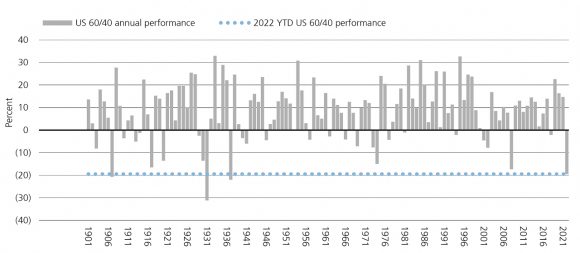
Exhibit 2: History of five-year expected annual returns for a global 60/40 portfolio
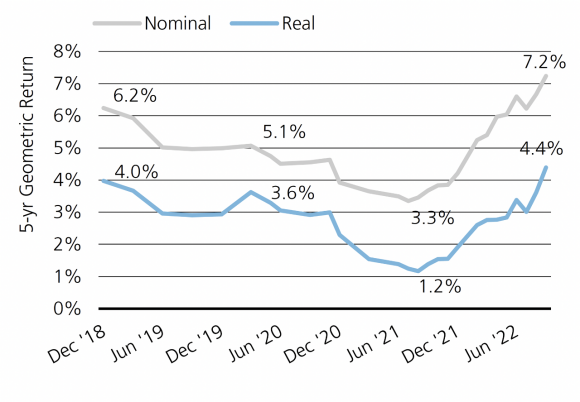
Key changes to our assumptions
Key changes to our assumptions
The main driver of better expected returns across asset classes is the improvement in valuations relative to those embedded in our capital market assumptions from mid-year 2021. More favorable valuations, while retaining a similar outlook for real activity, naturally entail higher return expectations, all else being equal. Our expected return on cash has increased substantially, from less than 1.0% to 3.7%, following substantial interest rate hikes by central banks. The extent of monetary tightening is linked to another change in our estimates: the average outlook for inflation over this horizon, which has risen from near 2% to close to 3%. Importantly, while more robust price pressures help improve nominal expected returns, expected real (inflation-adjusted) returns across asset classes have also improved materially.

Related
Macro updates
Macro updates
Keeping you up-to-date with markets
Exhibit 3: Five-year expected returns: Then and now
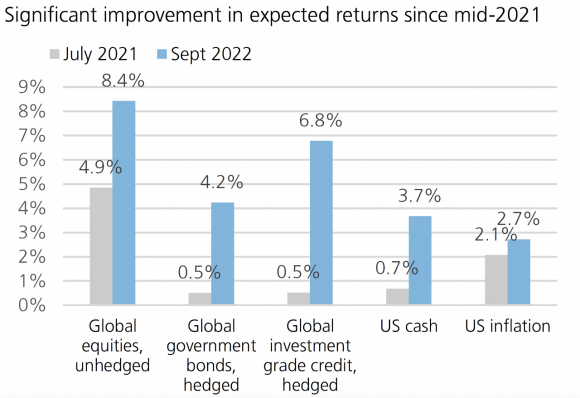
Exhibit 4: The disappearance of global negative-yielding debt
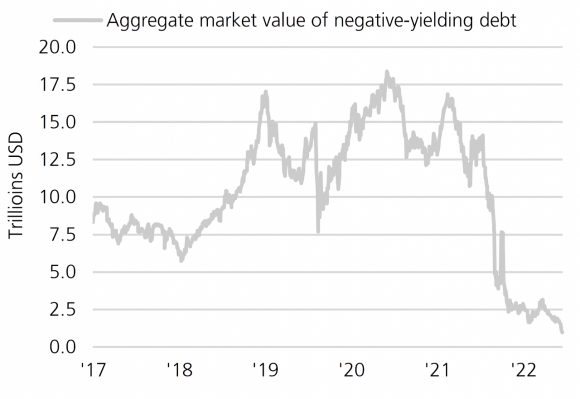
Currencies are another key consideration. The US dollar has become even more expensive over the past year, which in our projections increases the expected depreciation over time as it reverts towards fair value. We believe this is poised to boost returns for USD-based investors who hold international assets over a five-year horizon.
Return expectations
Return expectations
Across the major liquid asset class of equities, government bonds, and credit, our baseline outlook for expected returns is meaningfully higher as of September 2022 than in July 2021 (Exhibit 3). The improvement in the return profile is most evident in assets that pay a coupon – government bonds and credit – a function of the higher starting point for risk-free rates.
The end of the TINA era (“there is no alternative” besides stocks) is not primarily a bad news story for equities, in our view – it’s a good-news story on the outlook for multi-asset portfolios. Diversification may now be achieved in concert with positive expected returns across asset classes. That we have entered a regime in which there are many different ways to make money is a development perhaps best illustrated by the dwindling stock of negative-yielding debt globally (Exhibit 4).
Scenario analysis
Scenario analysis
We also explore how sensitive our return expectations are to different mixes of growth and inflation over two-year and five-year time frames:
- Deep recession: lower inflation, lower (or negative) growth.
- Stagflation: a sustained period of above-trend inflation and below-trend growth.
- Goldilocks: a moderation of inflation along with above-trend growth.
- Reflation: above-trend inflation and above-trend growth
As shown in the previous section, the global 60/40 portfolio has a nominal expected annual return of 7.2% and a real expected annual return of 4.4% over the next five years in our baseline projection. Over a two-year horizon, however, the range of possible outcomes remains wide. In the goldilocks and reflation outcomes, expected real returns are in the high single digits (double digits in nominal terms). But in the event of a deep recession or stagflation, expected real returns are negative.
Over a five-year time frame, stagflation is the only scenario in which expected real returns are negative (-5.8%), with a prolonged positive stock-bond correlation that challenges performance in all parts of the portfolio. Real five-year expected annual returns are modestly positive even in a deep recession (0.2%), while expected annual real returns are 5.0% and 7.0% in the goldilocks and reflation scenarios, respectively.
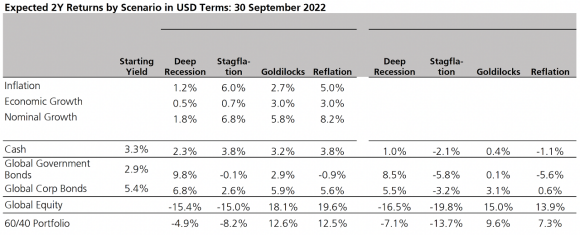
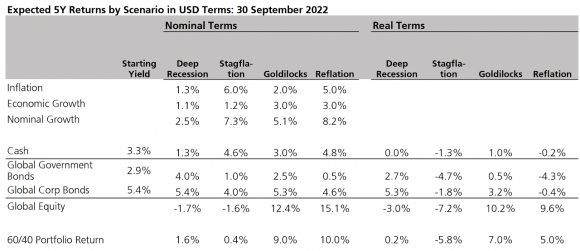
Tactical asset allocation implications
Tactical asset allocation implications
Our five-year capital market expectations send a clear message: 2022’s pain may be laying the foundation for better future gains. The medium and long-term investing backdrop is much more appealing now than it was in mid-2021.
However, our tactical asset allocation time frame of three-to-12 months demands that we use a more short-term filter in evaluating potential opportunities. We aim to use a blend of quantitative and qualitative analysis, balancing traditional business cycle dynamics with unique features of the current environment, to add alpha through tactical positioning within and between asset classes. As discussed, the range of return expectations by asset classes under varying macroeconomic scenarios remains wide, particularly under shorter-term horizons. We remain relatively cautiously positioned, with a neutral stance on equities, credit, and duration, and prefer more defensive and acyclical sectors and regions within the stock market.
And while there has been no place to hide this year in global equities, sovereign bonds, or credit, we retain exposure to the US dollar and commodities. These have performed well year to date through Q3, each up 14%, and we believe that they should continue to have diversifying properties, particularly in regimes which would be disruptive for risk assets.
Asset class attractiveness (ACA)
Asset class attractiveness (ACA)
The chart below shows the views of our Asset Allocation team on overall asset class attractiveness as of October 25, 2022. The colored squares on the left provide our overall signal for global equities, rates, and credit. The rest of the ratings pertain to the relative attractiveness of certain regions within the asset classes of equities, rates, credit and currencies. Because the ACA does not include all asset classes, the net overall signal may be somewhat negative or positive.
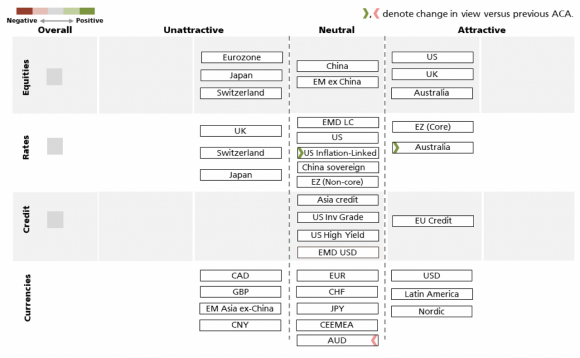
Read more
Make an inquiry
Fill in an inquiry form and leave your details – we’ll be back in touch.
Introducing our leadership team
Meet the members of the team responsible for UBS Asset Management’s strategic direction.


